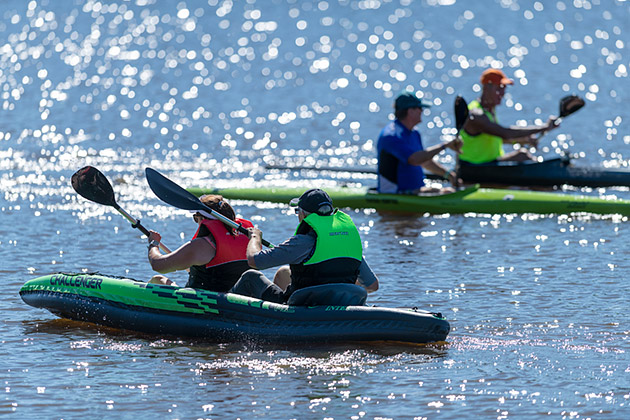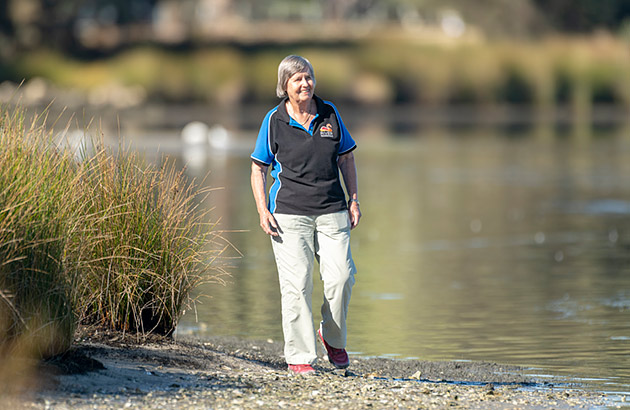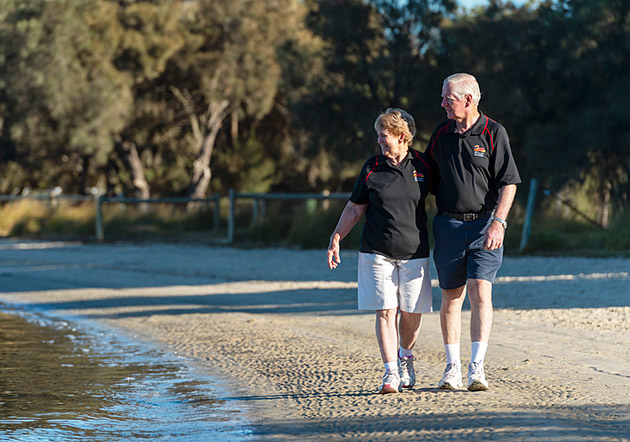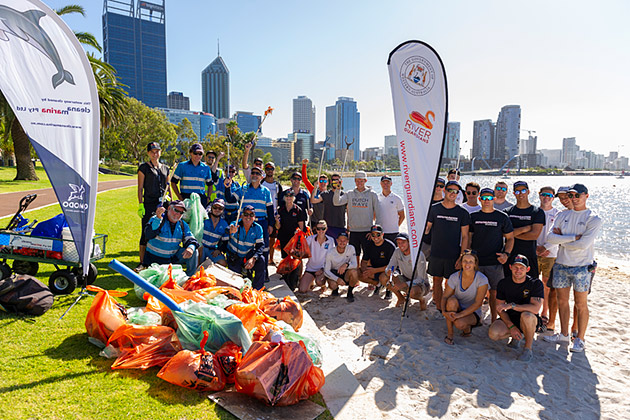22 February, 2019 By: Kerry Faulkner
West Australians have swum, fished, paddled and played along the Swan and Canning rivers for generations. Behind the scenes an army of volunteers are working to protect the water quality, plants and wildlife that make up the river we all love.
On her daily riverside walks with her dog Coco, Mt Pleasant resident Sue Harper is an avid spotter of dolphins and 'picker-upperer' of rubbish.
A decade-long member of the volunteer group River Guardians, Harper also empties the fishing line bins that dot the riverbank to stop the waste ending up in the water and killing wildlife.
It helps, but it’s not always enough. Only last year, one of the Swan’s well-known dolphins and her calf died in the river system after becoming entangled in discarded fishing line.
“It’s devastating,” Harper says. “I try not to be too sentimental about it but things like that [dolphin death] can bring me to tears because it’s so wasteful and completely avoidable.
“I try hard to prevent things like this in my own small way and it’s lovely to feel like I am making a difference.”

Harper is particularly passionate about the River Guardian’s Dolphin Watch program where more than 200 volunteers monitor the Swan and Canning river's 20-or-so strong resident dolphin population.
She’s watched them so closely and so often, she can tell each dolphin by the markings on its fin and has developed a passion for wildlife photography.
“It started off with me and my little camera not getting very good shots of dolphins and thinking ‘I need a better camera and better lenses to get better pictures of dolphins’,” she says.
Citizen scientists
There’s around 3000 River Guardian volunteers taking care of the Swan and Canning rivers, says Jason Menzies from the Department of Biodiversity, Conservation and Attractions, who manages the volunteers.
“Not all of them are active volunteers, but probably around half are involved with our Dolphin Watch program or the Reel it in program where they adopt one of the fishing line bins and monitor and empty them. Others are involved on an ad hoc basis.”
As well as Dolphin Watch and the Reel it in program, River Guardians also runs education programs with schools, plus clean-ups and restoration programs along the river bank.
Menzies says the Dolphin Watch program is one of the best examples of citizen science out there.
"Dolphin Watch was launced in 2009 off the back of six dolphin deaths that year which led us to realise that we didn’t know a lot about the resident population of bottlenose dolphins."
The project recruits volunteers and trains them up to understand the estuarine system and how to identify the dolphins and their behaviours.
“It was one of the first and is still today one of the leading citizen science projects in Australia. We’re approaching a 10-year anniversary this year. Over that journey we’ve had in excess of 20,000 reports from our Dolphin Watch volunteers.
“That’s helping scientists at ECU and Murdoch better understand how the resident dolphin population is using the Swan Canning River Park, which individuals are using it, and which time of year. “
Enjoying this article?
Sign up to our monthly enews
Our river connection
Fellow River Guardian Jennie Hunt is also part of the dolphin spotting cohort. However, her particular passion is protecting the Swan Estuary Marine Park, particularly around Alfred Cove, home to migratory wader birds that visit every summer from as far afield as Siberia.
Originally from Sydney, Hunt was recognised in 2011 with a Citizen Scientist Award for her detailed notetaking about river conditions and the behaviour of its inhabitants.
“I find it remarkable that as a capital city we have dolphins virtually swimming by the front door,” she says.
She worries when she sees people feeding bread to the water birds. As well as being bad for the birds the ingredients can contribute to dangerous algal blooms. Another frustration is those who ignore the ‘no dogs’ signs aimed at protecting the birds and their habitats.
“The dogs scare the birds, and also the dog poo being washing into the river impacts the water quality resulting in algal blooms,” she says.

Menzies says many people don’t fully understand the connection we have to our rivers. As well as encouraging people to respect the signage and pick up rubbish, he also wants us to think about what we do at home.
“A lot of people don’t make the connection between their backyards, the drains on the roads and their link straight to the river system,” he says.
“Even what people do in their yards is important. We don’t want them putting excess fertiliser on their lawns or fertilising before rain because that goes straight down the drain and into the river, causing algae blooms and nitrification. That can lead to deoxygenation and fish deaths.”
Everyone can help
Shelley’s Peter Agar says his memories of a childhood spent in and around the river prompted him and his wife Trita to become River Guardians.
They take a rubbish bag on their daily walks de-littering the popular picnic spots near their home and talking to other walkers about the river.
“We walk and talk to people and a lot of them seem to have the same love of the river we have. The river is a very social place,” he says.

He’s instilled in his own kids and grandkids a respect for the river wildlife and will happily approach kids or groups larking around and throwing jellyfish and ask them to stop.
“Where possible people should leave the river to nature – get your good use out of it, swimming and boating, but respect nature, the birdlife, the fish and the river bank itself,” he says.
Menzies says there is always a need for more River Guardian volunteers.
“We absolutely would like more. We run training sessions throughout the year, we sign people up and we give them the equipment they need.
“Every one of them does something within their capacity. It’s a sign of custodianship and that they value our rivers.”
If you're interested in becoming a River Guardian or just want to help out at the next clean-up day, visit riverguardians.com

Inspired to live a little more sustainably?
If you drive a car recognised by RAC as having lower emissions, you can get discounts across Insurance, Finance, Auto Services and Roadside Assistance.
